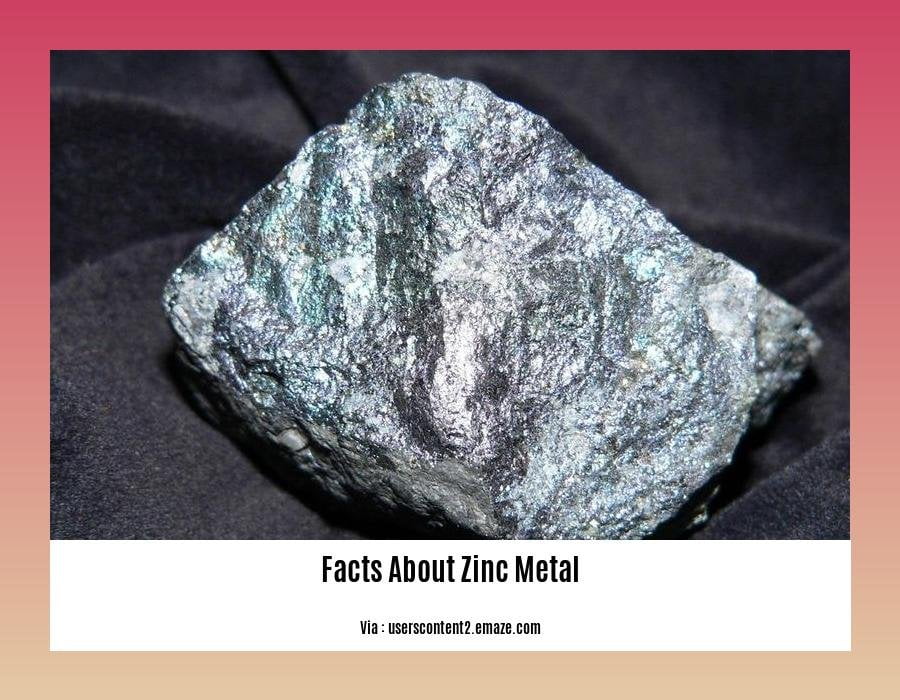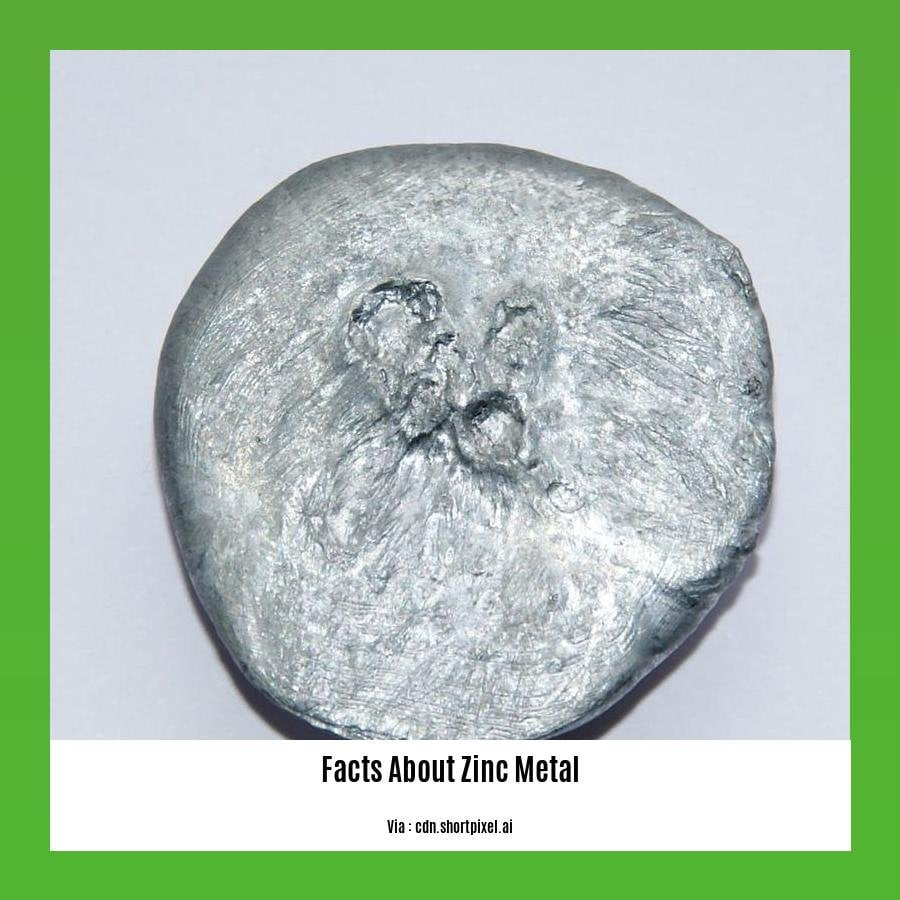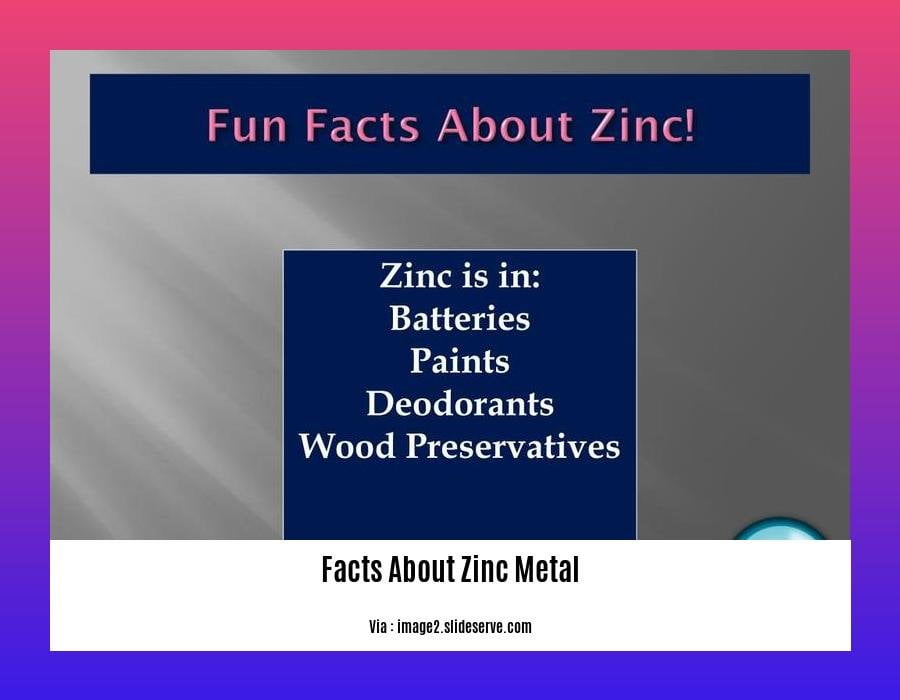Dive into the captivating world of zinc metal as we unveil 10 fascinating facts about its properties, applications, and more in this comprehensive guide. Explore the unique characteristics that make zinc an essential element in various industries and discover its versatility and significance in our daily lives.
Key Takeaways:
Zinc is the fourth most commonly used metal after iron, aluminum, and copper.
When exposed to air, zinc forms a layer of zinc carbonate to protect itself from further reactions.
Zinc is the last element in the fourth period of the transition metals.
It is found only in combination with other elements and has never been found in pure form naturally.
Zinc has a bluish-white shiny appearance when pure and is resistant to corrosion.
Zinc burns white-green in a flame test.
At a temperature of 1000°C, zinc becomes malleable and ductile.
Facts about Zinc Metal

Zinc, a lesser-known metal compared to iron, aluminum, and copper, holds a unique position as the fourth most commonly used metal in today’s world. But there’s more to zinc than meets the eye. Let’s delve into some fascinating facts about zinc metal:
1. Nature’s Protective Layer:
When exposed to air, zinc forms a thin layer of zinc carbonate, acting as a shield against further reactions with air or water.
2. The Last One of Its Kind:
Zinc is the last transition metal of the fourth period in the periodic table, making it a unique element.
3. Never Pure in Nature:
Unlike many other metals, zinc has never been found in its pure form in nature.
4. A White-Green Flame:
If you ever put zinc to a flame test, you’ll witness a beautiful white-green flame, a characteristic unique to zinc.
5. Bluish-White Beauty:
When pure, zinc appears as a bluish-white metal that shines brilliantly and resists corrosion.
6. Malleability and Ductility Unveiled:
Heat zinc to 1000°C, and you’ll discover its malleability and ductility, allowing it to be shaped and formed with ease.
7. Essential for Life:
Although we don’t realize it, zinc is an essential element for all living organisms, playing a crucial role in various biological processes.
8. Galvanization: Protecting Against Rust:
Zinc plays a heroic role in protecting iron and steel from rust through a process called galvanization, extending their lifespan significantly.
9. Zinc in Our Cells:
Zinc is a vital component of many enzymes in our cells, making it indispensable for a variety of bodily functions.
10. A Versatile Metal for Alloys:
Zinc is extensively used in alloys like brass, which is a combination of zinc and copper, and is valued for its strength and resistance to corrosion.
So, there you have it – 10 fascinating facts about zinc metal. From its protective nature to its essential role in our bodies, zinc is a truly remarkable element.
Did you know that forensic science has been helping mankind convict or acquit suspects for over a century? Discover more intriguing details that you were previously unaware of by clicking interesting facts about forensic science.
The polar bears and killer whales are just two of the incredible animals that may be found in the Earth’s watery realm. Click life below water facts for more information.
Ever wondered how your favorite land animals survive in their respective ecosystems? Head to facts about life on land to learn the most fascinating realities and curiosities.
Zinc in Human Health: Essential Mineral, Deficiency, & Toxicity
Zinc, an essential mineral, plays a vital role in our health, aiding various bodily functions and processes. However, a deficiency of zinc can lead to a range of health problems.
Zinc’s Essential Role:
– Immunity: Strengthens the immune system, helping to fight off infections.
– Wound Healing: Promotes wound healing and tissue repair.
– Taste and Smell: Essential for taste and smell perception.
– Cellular growth: Crucial for cell growth and division.
– DNA Synthesis: Plays a role in DNA synthesis and gene expression.
Consequences of Zinc Deficiency:
– Loss of taste and smell. Zinc deficiency can lead to a loss in the ability to taste or smell.
– Impaired immunity. A zinc deficiency can lead to impaired immune function, as it is needed for the proper functioning of white blood cells, which help fight infections.
– Delayed wound healing. Zinc is necessary for collagen synthesis, which is essential for wound healing. A deficiency can lead to delayed wound healing.
– Chronic inflammation. Zinc deficiency has been linked to chronic inflammation, which is associated with an increased risk of heart disease, cancer, and mental decline.
Food Sources:
– Meat, Poultry, and Seafood: Zinc-rich animal products include oysters, beef, crab, pork, and chicken.
Zinc Toxicity:
Symptoms include nausea, vomiting, stomach cramps, headaches, and fatigue. Excessive zinc intake can also lead to a copper deficiency.
Conclusion:
Zinc is essential for maintaining good health. A balanced diet that includes zinc-rich foods is the best way to ensure adequate zinc intake, but it is always advisable to consult a healthcare professional before taking zinc supplements, as they can have side effects.
Key Takeaways:
- Zinc is crucial for immune function, wound healing, and cellular growth.
- Zinc deficiency can lead to impaired immunity, delayed wound healing, loss of taste and smell, and chronic inflammation.
- Zinc in human health: essential mineral, deficiency, & toxicity is a topic that requires more research and public awareness.
- Zinc-rich foods like meat, poultry, and nuts are important for maintaining adequate zinc levels.
- Zinc toxicity can occur from excessive supplementation and can cause side effects.
- A balanced diet and proper supplementation, if necessary, can help ensure optimal zinc levels for good health.
Relevant URL Sources:
– Zinc – Health Professional Fact Sheet – Office of Dietary Supplements
– Zinc Deficiency – StatPearls – NCBI Bookshelf
Environmental impact of zinc: importance & concerns

Zinc, a versatile metal widely used in various industries, has garnered attention due to its potential impact on the environment. Let’s delve into the importance and concerns surrounding zinc’s environmental footprint:
Importance of Zinc
Essential Nutrient: Zinc is a vital nutrient for plants, animals, and humans, playing a crucial role in numerous biological processes. Its presence in soil is essential for plant growth and development.
Industrial Applications: Zinc’s unique properties, such as corrosion resistance and malleability, make it a valuable material in various industries, including construction, automotive, and electronics.
Concerns about Zinc’s Environmental Impact
Mining and Extraction: Zinc mining and extraction processes can lead to environmental disturbances, including habitat destruction, air pollution, and water contamination.
Industrial Effluents: Zinc-containing industrial effluents discharged into water bodies can harm aquatic ecosystems by altering water quality, affecting aquatic life, and contaminating sediments.
Accumulation in Soil: Excessive zinc in soil can result from agricultural practices, such as the application of zinc-based fertilizers, leading to soil contamination and potential toxicity to plants and soil microorganisms.
Air Pollution: Zinc emissions from industrial activities, such as metal smelting and burning of fossil fuels, can contribute to air pollution, posing health risks to humans and affecting air quality.
Toxicity to Aquatic Life: Elevated zinc levels in water bodies can be toxic to aquatic organisms, disrupting their physiological processes and affecting their survival and reproduction.
Mitigating Strategies
Responsible Mining Practices: Implementing sustainable mining practices that minimize environmental damage and promote responsible waste management can help reduce the negative impacts of zinc mining.
Wastewater Treatment: Treating industrial wastewater to remove zinc and other contaminants before releasing it into the environment can help protect water quality and aquatic ecosystems.
Best Agricultural Practices: Adopting best management practices in agriculture, such as using zinc fertilizers judiciously and implementing soil testing to determine zinc requirements, can minimize zinc accumulation in soil.
Recycling and Reuse: Recycling zinc from end-of-life products and using recycled zinc in manufacturing processes can reduce the need for mining and conserve natural resources.
Public Awareness: Raising awareness about the environmental impact of zinc and promoting responsible use and disposal of zinc-containing products can help mitigate its negative effects on the environment.
Key Takeaways:
- Zinc is an essential nutrient for living organisms but its environmental impact raises concerns.
- Mining, industrial effluents, and agricultural practices contribute to zinc pollution.
- Zinc accumulation in soil and water bodies can harm plants, aquatic life, and human health.
- Responsible mining practices, wastewater treatment, and sustainable agricultural practices are crucial for mitigating zinc’s environmental impact.
- Recycling and public awareness play a vital role in reducing the environmental footprint of zinc.
Relevant URL Sources:
- Zinc Essentiality, Toxicity, and Environmental Health
- Zinc | Public Health Statement | ATSDR – CDC
Zinc recycling: methods & benefits
As a metallurgy veteran, I’ve had the privilege of witnessing the evolution of zinc recycling. This amazing metal, with its versatile properties, has a sustainable side that’s worth exploring. Here’s the scoop on zinc recycling: methods & benefits!
Methods of Recycling Zinc
1. Pyrometallurgy:
– Heating zinc-containing materials (like ores or scrap) in a furnace.
– Zinc vaporizes and condenses, leaving behind impurities.
2. Hydrometallurgy:
– Using chemical solutions to dissolve zinc from ores or scrap.
– Zinc is then recovered through electrolysis or precipitation.
Benefits of Recycling Zinc
- Environmental Conservation:
- Reduces the need for mining, saving energy and resources.
Minimizes waste generation and pollution from mining activities.
Resource Efficiency:
- Zinc can be recycled indefinitely without losing its properties.
Contributes to a circular economy, maximizing resource utilization.
Energy Savings:
- Recycling zinc requires less energy compared to primary production.
Saves up to 95% energy compared to extracting zinc from ores.
Economic Benefits:
- Recycling zinc creates jobs and boosts the recycling industry.
- Reduces the need for importing zinc, saving on foreign exchange.
Conclusion
Zinc recycling isn’t just a buzzword, it’s a crucial practice that benefits both the environment and the economy. This process not only conserves natural resources but also contributes to sustainability and circularity. By embracing zinc recycling, we can create a greener and more sustainable future.
Key Takeaways:
- Zinc recycling methods: pyrometallurgy (heating) and hydrometallurgy (chemical solutions).
- Benefits of zinc recycling: environmental conservation, resource efficiency, energy savings, and economic benefits.
- Zinc recycling contributes to sustainability by reducing mining, waste, and energy consumption.
Relevant URL Sources:
FAQ
Q1: What are some unique properties of zinc metal?
A1: Zinc is known for its resistance to corrosion, as it forms a protective layer of zinc carbonate when exposed to air. Additionally, zinc is bluish-white in color and exhibits malleability and ductility when heated to temperatures around 1000°C.
Q2: What are some common applications of zinc metal?
A2: Zinc finds widespread use in galvanizing steel to protect it from corrosion. It is also used in the production of various alloys, such as brass and bronze, and in the manufacturing of batteries, electronics, and medical devices.
Q3: How does zinc affect human health?
A3: Zinc is an essential micronutrient for humans, playing a crucial role in immune function, wound healing, and cellular growth. Zinc deficiency can lead to impaired immune function, increasing the risk of infections, chronic diseases, and delayed wound healing.
Q4: What are the environmental implications of zinc?
A4: Zinc can enter the environment through natural processes like weathering and industrial activities. Excessive zinc levels can alter soil and aquatic microbial diversity and affect the bioavailability of other metals.
Q5: How can we recycle zinc metal?
A5: Zinc is a non-ferrous metal that can be recycled endlessly without losing its properties. Over 80% of the zinc available for recycling is recycled, contributing to sustainability and reducing environmental impact. Zinc recycling also plays a key role in fostering a circular economy for die casting.












